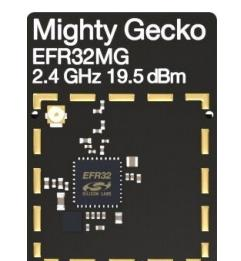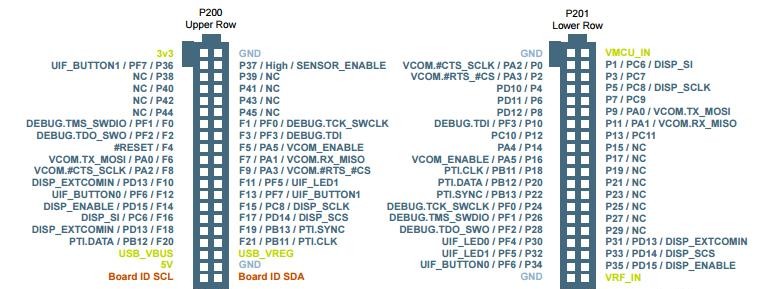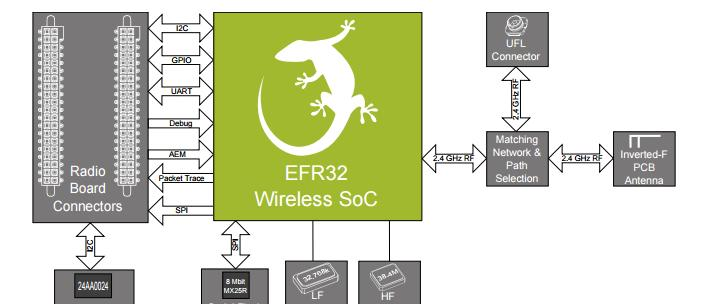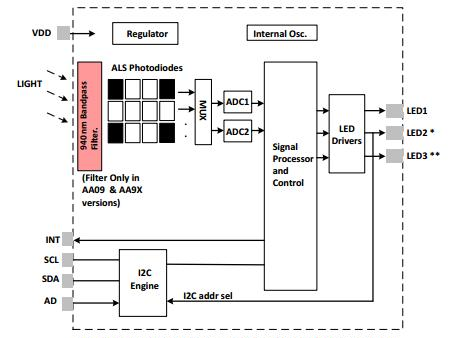基于EFR32MG/Si1153主控器件的LED智能照明解决方案
 375
375
 拍明
拍明
方案概述
LED智能照明解决方案通过在LED控制器上增加无线智能模块(ZigBee模块、Thread模块),降低布线成本和故障维修成本,从而有效控制施工和维护成本;同时,由于其特有的自动连接/自动重新连接功能保证了通信的可靠性和易用性,在控制中心可以实现开关、调光调色功能;此外通过接入光线传感器,可以有效提高能源的利用效率,节约能源。
优势
• 无线SOC EFR32MG射频部分内部集成PA(直接输出+20dbm,不需要额外加功率放大)和Balun电路,减少电路外围器件,方便布板,减少PCB尺寸,方便安装,降低了BOM成本;
【EFR32MG】
EFR32MG 2.4 GHz 19.5 dBm Radio Board BRD4151A Reference Manual
The EFR32MG family of Wireless SoCs deliver a high performance, low energy wireless solution integrated into a small form factor package.
By combining a high performance 2.4 GHz RF transceiver with an energy efficient 32-bitMCU, the family provides designers the ultimate in flexibility with a family of pin-compatible devices that scale from 128/256 kB of flash and 16/32 kB of RAM. The ultra-low power operating modes and fast wake-up times of the Silicon Labs energy friendly 32- bit MCUs, combined with the low transmit and receive power consumption of the 2.4 GHz radio, result in a solution optimized for battery powered applications.
To develop and/or evaluate the EFR32 Mighty Gecko, the EFR32MG Radio Board can be connected to the Wireless Starter Kit Mainboard to get access to display, buttons and additional features from Expansion Boards.

RADIO BOARD FEATURES
• Wireless SoC:EFR32MG1P232F256GM48
• CPU core: ARM Cortex-M4 with FPU
• Flash memory: 256 kB
• RAM: 32 kB
• Operation frequency: 2.4 GHz
• Transmit power: 19.5 dBm
• Integrated PCB antenna, UFL connector(optional).
• Crystals for LFXO and HFXO: 32.768 kHzand 38.4 MHz.
1. Introduction
The EFR32 Mighty Gecko Radio Boards provide a development platform (together with the Wireless Starter Kit Mainboard) for theSilicon Labs EFR32 Mighty Gecko Wireless System on Chips and serve as reference designs for the matching network of the RF interface.
The BRD4151A Radio Board is designed to operate in the 2400-2483.5 MHz band with the RF matching network optimized to operatewith 19.5 dBm output power.
To develop and/or evaluate the EFR32 Mighty Gecko, the BRD4151A Radio Board can be connected to the Wireless Starter Kit Mainboardto get access to display, buttons and additional features from Expansion Boards and also to evaluate the performance of the RFinterface.
2. Radio Board Connector
2.1 Introduction
The board-to-board connector scheme allows access to all EFR32MG1 GPIO pins as well as the RESETn signal. For more information on the functions of the available pin functions, see the EFR32MG1 data sheet.
2.2 Radio Board Connector Pin Associations
The figure below shows the pin mapping on the connector to the radio pins and their function on the Wireless Starter Kit Mainboard.

3. Radio Board Block Summary
3.1 Introduction
This section gives a short introduction to the blocks of the BRD4151A Radio Board.
3.2 Radio Board Block Diagram
The block diagram of the EFR32MG Radio Board is shown in the figure below.

3.3 Radio Board Block Description
3.3.1 Wireless MCU
The BRD4151A EFR32 Mighty Gecko Radio Board incorporates an EFR32MG1P232F256GM48 Wireless System on Chip featuring32-bit Cortex-M4 with FPU core, 256 kB of flash memory and 32 kB of RAM and a 2.4 GHz band transceiver with output power up to19.5 dBm. For additional information on the EFR32MG1P232F256GM48, refer to the EFR32MG1 Data Sheet.
3.3.2 LF Crystal Oscillator (LFXO)
The BRD4151A Radio Board has a 32.768 kHz crystal mounted.
3.3.3 HF Crystal Oscillator (HFXO)
The BRD4151A Radio Board has a 38.4 MHz crystal mounted.
3.3.4 Matching Network for 2.4 GHz
The BRD4151A Radio Board incorporates a 2.4 GHz matching network which connects the 2.4 GHz TRX pin of the EFR32MG1 to the one on-board printed Inverted-F antenna. The component values were optimized for the 2.4 GHz band RF performace and current consumptionwith 19.5 dBm output power.
For detailed description of the matching network, see Chapter 4.2.1 Description of the 2.4 GHz RF Matching.
3.3.5 Inverted-F Antenna
The BRD4151A Radio Board includes a printed Inverted-F antenna (IFA) tuned to have close to 50 Ohm impedance at the 2.4 GHzband.
For detailed description of the antenna see Chapter 4.5 Inverted-F Antenna.
3.3.6 UFL Connector
To be able to perform conducted measurements, Silicon Labs added an UFL connector to the Radio Board. The connector allows anexternal 50 Ohm cable or antenna to be connected during design verification or testing.Note: By default the output of the matching network is connected to the printed Inverted-F antenna by a series component. It can beconnected to the UFL connector as well through a series 0 Ohm resistor which is not mounted by default. For conducted measurementsthrough the UFL connector the series component to the antenna should be removed and the 0 Ohm resistor should be mounted (seeChapter 4.2 Schematic of the RF Matching Network for further details).
3.3.7 Radio Board Connectors
Two dual-row, 0.05” pitch polarized connectors make up the EFR32MG Radio Board interface to the Wireless Starter Kit Mainboard.
For more information on the pin mapping between the EFR32MG1P232F256GM48 and
the Radio Board Connector, refer to Chapter 2.2 Radio Board Connector Pin
Associations.
• 无线SOC EFR32MG支持多频段(2.4GHZ、Sub-G)、多协议(Zigbee/Thread/BLE/私有协议)芯片型号可选,产品之间兼容性好,产品系列丰富,方便系统级产品布局;
• 无线SOC EFR32MG 支持多种硬件加密方式(ECC/SHA-1/SHA-2/AES-128/AES-256),可以有助设计更高安全级别的产品;
• 芯片自带 PTI(Packet Trace Interface)硬件接口,方便系统级的无线网络通信调试。
• 具备数字I2C接口输出的光传感器Si1153,功耗低(睡眠电流小于500nA,工作电压低至1.62V),有效延长电池使用寿命;且可以在阳光下工作,配合使用可解决恒照度照明应用场合;
【Si1153】
Proximity/Ambient Light Sensor IC with I2C Interface
The Si1153-AA00/AA09/AA9x is an ambient light sensor, proximity, and gesture detectorwith I2C digital interface and programmable-event interrupt output.

This touchless sensor IC includes dual 23-bit analog-to-digital converters, an integratedhigh-sensitivity array of visible and infrared photodiodes, a digital signal processor, andthree integrated LED drivers with programmable drive levels. The Si1153 offers excellentperformance under a wide dynamic range and a variety of light sources, includingdirect sunlight. The Si1153 can also work under dark glass covers. The photodiode responseand associated digital conversion circuitry provide excellent immunity to artificiallight flicker noise and natural light flutter noise. With two or more LEDs, the Si1153 iscapable of supporting multiple-axis proximity motion detection. The Si1153 is provided ina 10-lead 2x2 mm DFN package or in a 10-lead 2.9x4.9 mm LGA module with integratedLED, and is capable of operation from 1.62 to 3.6 V over the –40 to +85 °C temperaturerange.
KEY FEATURES
• Proximity detector
• From under 1 cm, to 50 cm withoutadditional lensing.
• From under 1 cm, to 200 cm with additional lensing (e.g., 5 mm hemispherical lens as in our EVB).
• Up to three independent LED drivers.
• 30 current settings from 5.6 mA to 360mA for each LED driver.
• Operates in direct sunlight with optionalon-die 940 nm passband filter.
• On die 940 bandpass filter that rejectsunwanted visible light and IR fromdaylight and other sources (Si1153-AA09/AA9X).
• Ambient light sensor
• <100 mlx resolution possible, allowingoperation under dark glass.
• Up to 128 klx dynamic range possibleacross two ADC range settings.
• Industry’s lowest power consumption
• 1.62 to 3.6 V supply voltage.
• 9 μA average current (LED pulsed 25.6μs every 800 ms at 180 mA plus 3 μASi1153 supply).
• <500 nA standby current.
• 25.6 μs LED “on” time keeps total powerconsumption duty cycle low withoutcompromising performance or noisecommunity.
• Internal and external wake support.
• Built-in voltage supply monitor andpower-on reset controller.
APPLICATIONS
• Wearables
• Handsets
• Display backlighting control
• Consumer electronics
1. Feature List
• Proximity detector
• From under 1 cm to 50 cm without additional lensing.
• From under 1 cm to 200 cm with additional lensing (e.g., 5mm hemispherical lens).
• Up to three independent LED drivers.
• 30 current settings from 5.6 mA to 360 mA for each LEDdriver.
• Operates in direct sunlight with optional on-die 940 nmpassband filter.
• On die 940 bandpass filter that rejects unwanted visible lightand IR from daylight and other sources (Si1153- AA09/AA9X).
• Ambient light sensor
• <100 mlx resolution possible, allowing operation under darkglass.
• Up to 128 klx dynamic range possible across two ADCrange settings.
• Industry’s lowest power consumption
• 1.62 to 3.6 V supply voltage.
• 9 μA average current (LED pulsed 25.6 μs every 800 ms at180 mA plus 3 μA Si1153 supply).
• <500 nA standby current.
• 25.6 μs LED “on” time keeps total power consumption dutycycle low without compromising performance or noise community.
• Internal and external wake support.
• Built-in voltage supply monitor and power-on reset controller.
• Trim-able internal oscillator with typical 1% accuracy.
• I2C Serial communications
• Up to 3.4 Mbps data rate.
• Slave mode hardware address decoding.
• Two package options:
• 10-lead 2 x 2 x 0.65 mm DFN
• 10-lead 2.9 x 4.9 x1.2 mm LGA module with integrated 940nm LED
• Temperature Range: –40 to +85 °C
相关元件供应
型号:SI1133-AA00-GMR 品牌:SILICON LABS
型号:SI1153-AA09-GMR 品牌:SILICON LABS
型号:EFR32MG1P232F256GM48-C0R 品牌:SILICON LABS
型号:EFR32MG1P232F256GM48-C0 品牌:SILICON LABS
型号:EFR32MG1P232F256GM32-C0 品牌:SILICON LABS
型号:SI1153-AA09-GM 品牌:SILICON LABS
【智能照明】
智能照明是指利用物联网技术、有线/无线通讯技术、电力载波通讯技术、嵌入式计算机智能化信息处理,以及节能控制等技术组成的分布式照明控制系统,来实现对照明设备的智能化控制。
智能照明是指利用计算机、无线通讯数据传输、扩频电力载波通讯技术、计算机智能化信息处理及节能型电器控制等技术组成的分布式无线遥测、遥控、遥讯控制系统。具有灯光亮度的强弱调节、灯光软启动、定时控制、场景设置等功能;并达到预定的特点。
城市
城市智能照明系统作为智慧城市的核心子系统,运用无线Zigbee、WiFi、GPRS等多种物联网和IT技术,实现了远程单灯开关、调光、检测等管控功能,开辟了城市照明“管理节能”的新篇章。
本系统整合了路灯、隧道灯、景观灯、商业照明、学校机关照明等照明系统,用一个统一的平台来进行管理。本系统是一个开放的系统,预留了各种接入方式,可进一步打造成智慧城市“云 ”系统。
系统特点:
1、 回路控制和控制箱门开报警、水浸报警;
2、 回路电流、电压、功率因数、电量检测等;
3、 单灯开关和调光;
4、 单灯电流、电压、功率因素、电量和温度检测等;
5、 根据天气情况和实际的光照度,实现灯具的自动开、关和调光;
6、 灵活的亮灯组合管理、精确控制每一盏灯;
7、 现场管理功能
8、 预设管理功能
9、 每天可进行自动通、断电操作;可保证工作日、节假日按不同的时间自动通、断电;可对用电设备进行分区、分线路管理或单独管理;
10、集成无线抄表功能,为能耗管理打下基础;
11、监控灯具的开、关和亮度,从而显著延长灯具的有效寿命,减少灯具更换次数,节约资源,减少有害气体污染环境;
目前我国的城市道路照明管理信息化程度还较低,基于物联网和云计算的系统管理软件为路灯管理部门的信息化建设提供了一套全面的解决方案。
1、路灯自动巡检:监控中心能对安装了路灯监控器的路灯进行自动巡检,查报故障并自动生成报修单;
2、路灯查控:能实时对安装了路灯监控器的路灯进行开、关、调节亮度等功能,或预设控制方案,使路灯按照预设方案进行亮灯。
3、设备管理:对灯杆、灯具、电线、控制箱、变压器、电表、开关、监控器等路灯设备实现计算机信息化管理,具有设备安装、报废、维修、更换、出入库等功能。
4、多媒体功能:具有图片库管理功能、视频管理功能,使管理更具直观化、形象化和亲和化。
5、GIS地理信息系统:具有地形、设施空间、行政区划、街区、道路、建筑物、水系、管沟、路灯线路、控制线路、敷设情况等功能。
6、辅助分析模块:具有统计、报表、分析、查询、负荷计算、实时读表、用电分析、电缆长度计算等功能。
7、Web信息发布模块:与网站实现无缝对接,进行远程管理的功能。
性能特点:
控制路灯开关、亮度调节、电流、电压采集、被盗报警等,并预留了温度采集、灯杆倾斜检测等功能。
路灯管理器分为模块式(内置灯具中)和外挂式(可内置灯杆中),可分别满足路灯企业和工程企业的使用需求。
1、通过Zigbee无线自组网进行通信连接,实时在线收信息;
2、高性能嵌入式微处理器技术,先进的电能测量计量专用芯片,大容量存储器技术;
3、自诊断和自恢复功能;
4、断电数据保持功能;
5、远程或就地自动调光实现路灯的亮灯、暗灯的节能控制;
6、无线路由功能,实现通信的中继功能。
技术参数:
无线频率:2.4G ISM免费频段
平均功耗:0.4W/0.5W/0.7W
工作温度:-40℃~85℃
性能特点:
智能照明网关是实现路灯单灯监控的重要硬件设备,它使用Zigbee无线技术和灯控器通信,与系统中心的通信可以使用GPRS /CDMA、以太网、Wi-Fi网络或ADSL modem等一般安装在户外路灯控制箱内。
智能照明网关内置多种功能,包括:时序调度功能、报警功能、类型转换功能、内部实时时钟等功能。
一般情况下,一个可以管理300个左右的灯控器。
可以通过网关接入的产品有:控制箱管理器、灯控器、光感检测器、电缆防盗器、雨雪传感器等。
1、通过Zigbee无线自组网进行通信连接,实时在线收发信息;
2、进行路灯回路控制,具有自诊断和自恢复功能;
3、具有GPRS/CDMA、以太网、232、485、USB、CAN等通讯接口;
4、高性能嵌入式微处理器技术,高精度的电能测量计量专用芯片,大容量存储器技术;
5、具有时钟和预设控制的功能;
6、具有和三相电流、电压、功率因数、电量的测量功能;
7、具有水浸报警、控制箱门开报警功能。
技术参数:
无线频率:2.4G ISM免费频段
工作温度:-40℃~85℃
责任编辑:Davia
【免责声明】
1、本文内容、数据、图表等来源于网络引用或其他公开资料,版权归属原作者、原发表出处。若版权所有方对本文的引用持有异议,请联系拍明芯城(marketing@iczoom.com),本方将及时处理。
2、本文的引用仅供读者交流学习使用,不涉及商业目的。
3、本文内容仅代表作者观点,拍明芯城不对内容的准确性、可靠性或完整性提供明示或暗示的保证。读者阅读本文后做出的决定或行为,是基于自主意愿和独立判断做出的,请读者明确相关结果。
4、如需转载本方拥有版权的文章,请联系拍明芯城(marketing@iczoom.com)注明“转载原因”。未经允许私自转载拍明芯城将保留追究其法律责任的权利。
拍明芯城拥有对此声明的最终解释权。




 产品分类
产品分类















 2012- 2022 拍明芯城ICZOOM.com 版权所有 客服热线:400-693-8369 (9:00-18:00)
2012- 2022 拍明芯城ICZOOM.com 版权所有 客服热线:400-693-8369 (9:00-18:00)


